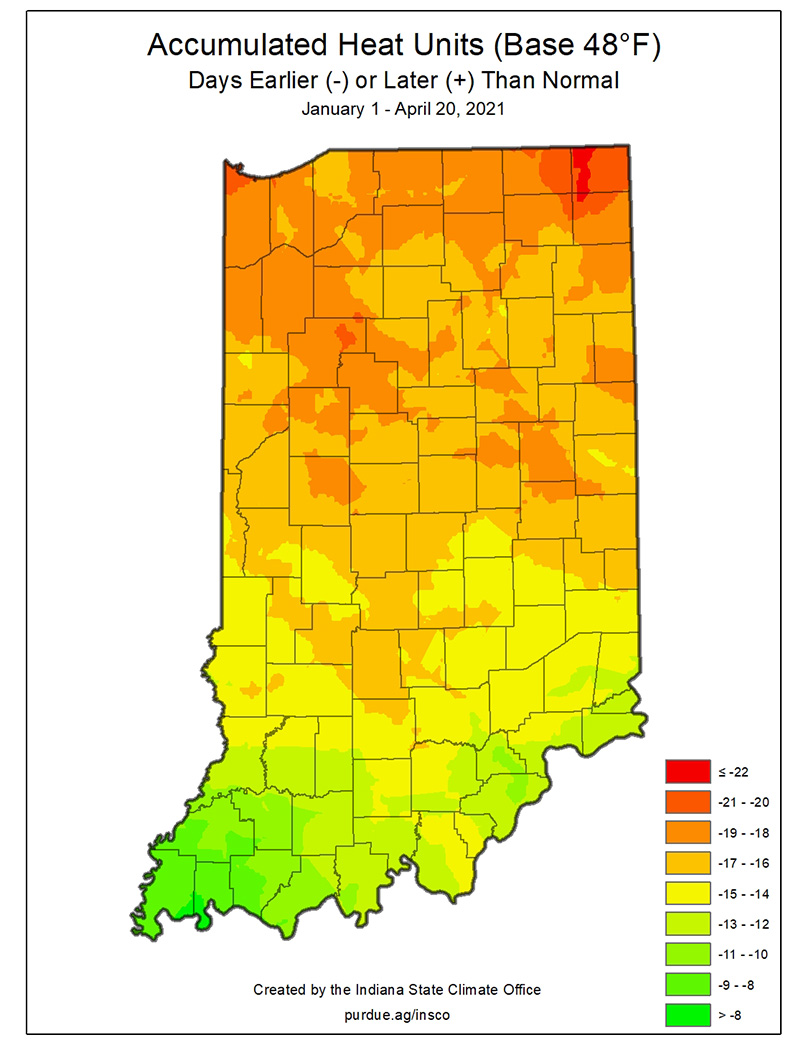Recent reports from pest managers in northern counties have indicated that weevil damage and larval numbers are very high, well in advance of typical numbers for this date. See accompanying map below. It seems that winters mild temperatures have allowed for higher levels of egg and adult over-wintering and that spring heat unit accumulations have accelerated larval development. Based on the numbers and size-variability of larvae, egg laying occurred over an extended period. This makes management a little tougher, as it means that egg hatch and larval development will be occurring over a longer period than normal. Alfalfa stands of four years or more are especially vulnerable to higher weevil populations…they should be scouted and managed if necessary.

These alfalfa weevil larvae were well and fine the day after freezing temperatures on April 20. (Photo Credit: John Obermeyer)
The snow and freezing temperatures over the last couple days may bend-down or discolor the alfalfa, but weevil larvae will not be harmed. Though the weevil ceases feeding activity when temperatures dip below 48°F, they are quite cold hardy and will survive just fine nestled among the folded leaves in the tips. Once warmer temperatures return – probably as you read this. – field scouting for alfalfa weevil damage should begin. Normally, at 250 heat units, base 48°F, accumulation from January 1 (see guidelines and map below) we recommend scouting. Sampling a field to determine the extent of alfalfa weevil damage and average stage of weevil development is best accomplished by walking through the field in an “M-shaped pattern.” Ten alfalfa stems should be examined in each of 5 representative areas of the field for a total of 50 stems from the entire field. Consider that south facing slopes and/or sandy soils warm sooner and should be prioritized for sampling. Each stem should be examined for evidence of tip feeding (pin-holes to skeletonized) and teasing out alfalfa weevil larvae from among damaged leaves. Although large alfalfa weevil larvae are relatively easy to find, small larvae are difficult to see; thus, very close examination of leaves may be required to detect “pin-hole” feeding, small black fecal pellets and small off-white to light green larvae. There are very few other insects feeding in alfalfa tips at this time of year.
By utilizing heat unit accumulation data to determine when management action should be taken, producers can get the greatest economic return. See guidelines and accumulated heat unit map below. If the application of an insecticide is required early in the weevil season, producers should select a material that has good residual action, and apply at the higher rate.
Alfalfa Weevil Management Guidelines Southern Indiana
| Heat Units | % Tip Feeding* | Advisory |
|---|---|---|
| 250 | Begin sampling. | |
| 300 | 0-50 | Re-evaluate in 7-10 days using the appropriate heat units or treat immediately with a residual insecticide if 3 or more larvae are noted per stem and % tip feeding is above 50% |
| 400 | 50 | Treat immediately with a residual insecticide. |
| 500 | 75 | Treat immediately. |
| 600 | 75+ | If cutting delayed more than 5 days, treat immediately. |
| 750 | If harvested or harvesting shortly, return to the field in 4-5 days after cutting and spray if 1) there is no regrowth and weevil larvae are present OR 2) feeding damage is apparent on 50% of the stubble and weevil larvae are present. |
*Note if larvae are still present, actively feeding and/or diseased.
Alfalfa Weevil Management Guidelines Northern Indiana
| Heat Units | % Tip Feeding* | Advisory |
|---|---|---|
| 250 | Begin sampling. | |
| 300 | 0-40 (30)* | Re-evaluate in 7-10 days using the appropriate heat units or treat immediately with a residual insecticide if 3 or more larvae are noted per stem and % tip feeding is above 50% |
| 400 | 60 (50)** | Treat immediately with a residual insecticide. |
| 500 | 75 | Treat immediately. |
| 600 | 75+ | If cutting delayed more than 5 days, treat immediately. |
| 750 | If harvested or harvesting shortly, return to the field in 4-5 days after cutting and spray if 1) there is no regrowth and weevil larvae are present OR 2) feeding damage is apparent on 50% of the stubble and weevil larvae are present. |
*Note if larvae are still present, actively feeding and/or diseased.
**Shorter than normal growth at beginning of season.




